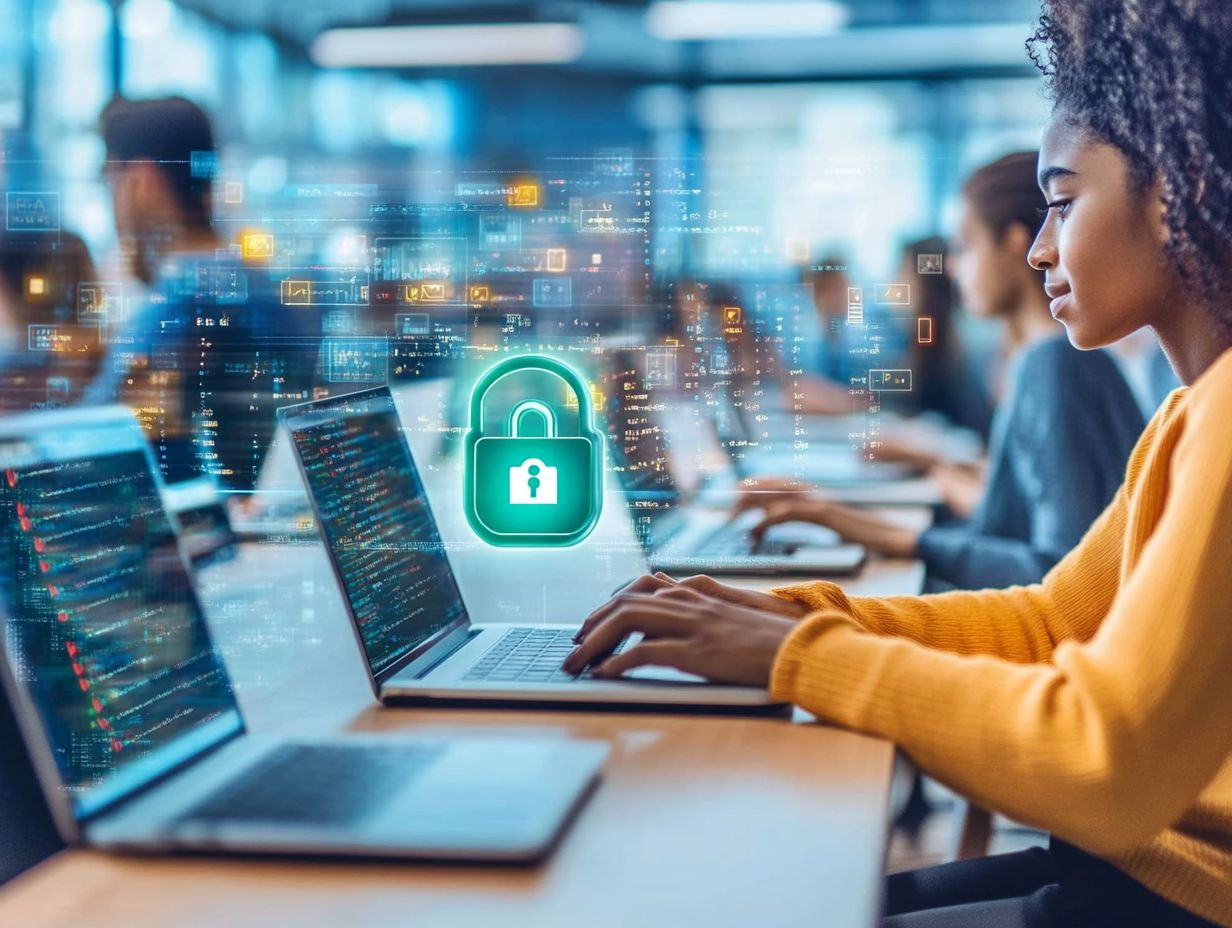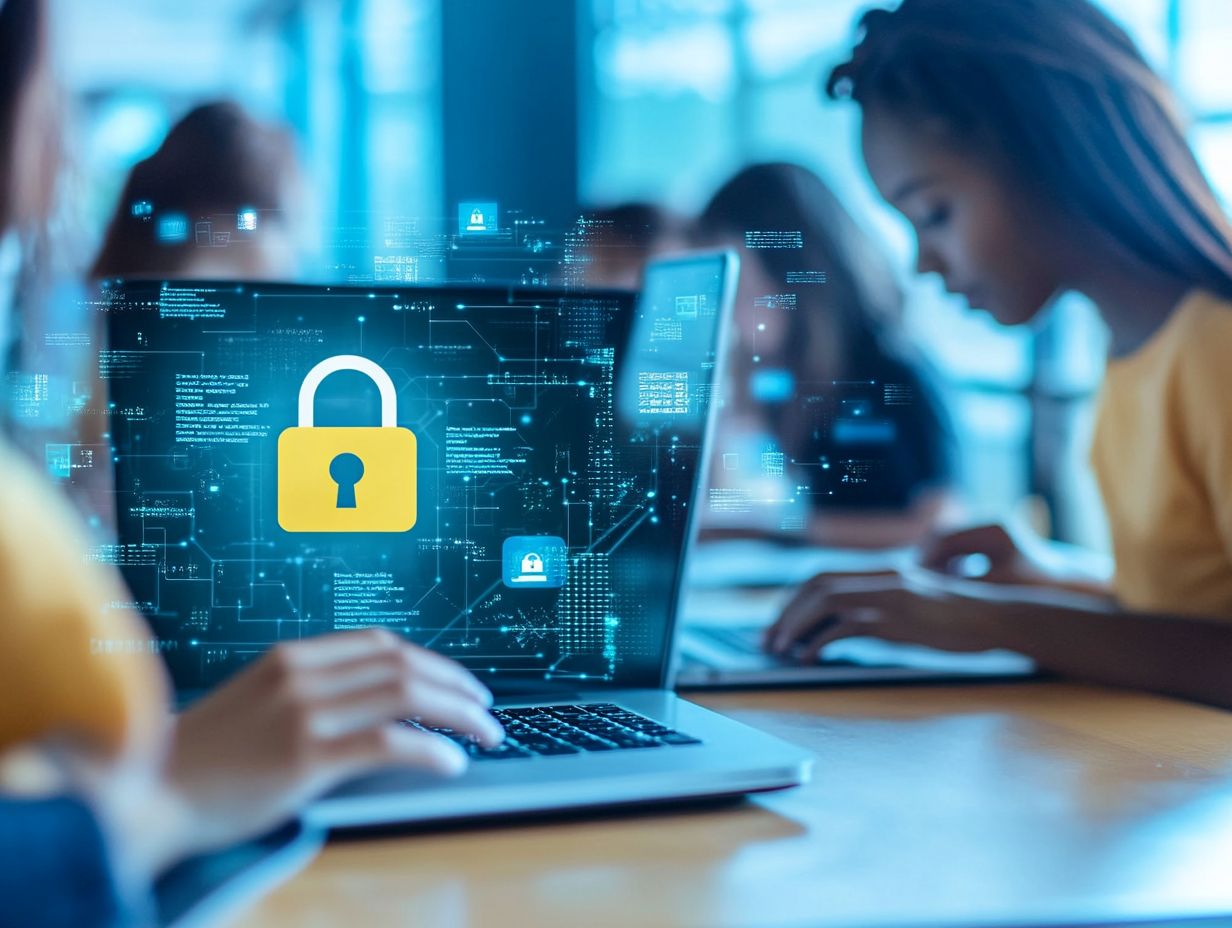How to Ensure Data Security in E-Learning
In today s digital landscape, e-learning has revolutionized how you acquire knowledge, making it more accessible than ever before.
However, this convenience brings with it a significant challenge: data security. Protecting sensitive information is paramount, especially as cyber threats evolve and target online platforms more often.
This article explores common threats to data security that you should know about within e-learning, outlines best practices for safeguarding your information, and highlights the importance of compliance with data privacy laws.
Join us as we uncover practical strategies for securing e-learning environments and enhancing user awareness.
Contents
- Key Takeaways:
- Common Threats to Data Security in E-Learning
- Protecting Data in E-Learning
- Implementing Secure E-Learning Platforms
- Data Privacy Laws and Regulations
- Training and Educating Users on Data Security
- Frequently Asked Questions
- What is data security in e-learning?
- Why is data security important in e-learning?
- How can I ensure data security in e-learning?
- What are some potential risks to data security in e-learning?
- What are some best practices for maintaining data security in e-learning?
- What should I do if I suspect a data security breach in e-learning?
Key Takeaways:

- Strengthen your e-learning data security by implementing best practices, such as regularly updating software and using strong passwords.
- Ensure compliance with data privacy laws in your e-learning platform to protect sensitive student information.
- Educate and train users on data security measures to prevent common threats like phishing attacks.
Why Data Security is Important in E-Learning
Data security is crucial in e-learning environments. Institutions must prioritize protecting sensitive personal information.
As the digital landscape evolves, data breaches threaten personal information. They also undermine the trust between educators and learners. The repercussions of such breaches can lead to legal challenges under GDPR and tarnish reputations that have taken years to cultivate.
Therefore, it is essential for educators and organizations to cultivate a culture of accountability and transparency. By prioritizing strong data protection practices, they not only meet compliance requirements but also create a secure environment that enables learners to engage wholeheartedly without the fear of data misuse.
Ultimately, a commitment to protecting personal data enhances the overall effectiveness of e-learning, fostering a safe haven for knowledge acquisition.
Common Threats to Data Security in E-Learning
In the world of e-learning, you ll encounter several common threats that can significantly jeopardize data security. Each one is capable of undermining the integrity and confidentiality of sensitive information exchanged between users and learning platforms.
These threats encompass data breaches that compromise personal information, cyber threats that exploit system vulnerabilities, and risks from third-party vendors that may not adhere to rigorous data protection standards.
You must stay alert to protect your data and implement robust incident response strategies to effectively safeguard it.
Types of Cyber Attacks
Cyber attacks manifest in many forms, each employing unique tactics aimed at compromising data security, especially in e-learning platforms that handle extensive personal data and sensitive information. You may find phishing schemes lurking around, targeting unsuspecting users to gain access to their credentials. Ransomware attacks can encrypt critical data, holding it hostage until a ransom is paid. This rising tide of cyber threats underscores the necessity for advanced authentication measures and strong security protocols to effectively combat these challenges.
Among the prevalent types of cyber attacks, Distributed Denial of Service (DDoS) attacks can inundate online educational resources, rendering them completely inaccessible to legitimate users. The exploitation of software vulnerabilities can lead to unauthorized data breaches that compromise student privacy. Man-in-the-middle attacks can intercept communication between users and the platform, potentially resulting in significant data theft.
These various attack vectors emphasize the urgent need for e-learning environments like yours to embrace comprehensive security strategies. Implementing multi-factor authentication and other strong measures is essential to safeguard against unauthorized access and ensure the integrity of your valuable educational data.
Protecting Data in E-Learning

Protecting data in e-learning environments necessitates a thorough and layered approach to security. This ensures the confidentiality, integrity, and availability of sensitive information, especially concerning employee details and the personal data of users engaging with online courses.
To achieve effective data protection, implement robust access controls and conduct regular security audits. Utilize data encryption techniques to safeguard information during transfer and storage. These measures reduce vulnerabilities and enhance your platform’s resilience against potential cyber threats.
Best Practices for Data Security
Adopting best practices for data security in e-learning significantly cuts risks and boosts your platform’s safety! This ensures that sensitive data remains protected against unauthorized access and breaches.
By proactively addressing these security concerns, you create a safe environment that protects user information while building trust among your users. Implementing multi-factor authentication serves as a robust barrier against unauthorized access, enhancing the security of your login processes.
Regular security audits provide invaluable insights into potential vulnerabilities, allowing you to strengthen defenses before exploitation occurs. Timely software updates ensure your platform benefits from the latest security patches, minimizing risks associated with outdated systems.
A well-defined incident response protocol speeds up recovery processes, managing any security incident swiftly and effectively. This reduces the impact on users and maintains operational integrity.
Implementing Secure E-Learning Platforms
Implementing secure e-learning platforms requires a strategic approach to user management and data processing. Ensure that sensitive personal data is handled in compliance with regulations like GDPR and the Data Protection Act, which are laws that help protect personal data.
A robust Learning Management System (LMS) is essential. It should integrate secure access controls and feature regularly updated software to safeguard against data breaches. Additionally, consider necessary precautions for third-party integrations, as these can introduce potential security risks.
Features and Considerations
When searching for a secure e-learning platform, weigh various features that bolster data security, such as robust access controls and a clear privacy policy outlining data handling practices. Ensure that the platform’s software usability aligns with security requirements, allowing you to navigate effortlessly while adhering to best practices for data protection and privacy.
The significance of access controls cannot be underestimated. They should enable administrators to effectively manage user permissions, ensuring that sensitive information remains accessible only to authorized individuals. Equally important is the privacy policy, which should transparently explain how personal data is collected, stored, and utilized, fostering trust among users.
A user-friendly interface is essential; it not only enhances your overall experience but also promotes compliance with security protocols. This makes it easier for you to engage fully without compromising your data. By integrating these elements, the platform creates a secure and inviting environment for your learning journey.
Data Privacy Laws and Regulations

Understanding data privacy laws and regulations is paramount for organizations in the e-learning sector. It’s crucial to comply with data laws now to protect your users and ensure the sensitive information you manage across various online platforms is safeguarded.
Regulations like GDPR and the Data Protection Act impose strict requirements on data processing. They underscore the critical need for transparency in how you handle data, secure user consent, and implement robust compliance measures. This diligence mitigates the risks associated with data breaches, protecting both your organization and your users.
Compliance and Implications for E-Learning
Compliance with data privacy laws in e-learning isn t just a legal formality; it s essential for building user trust. By prioritizing data protection and safeguarding user privacy, you enhance your organization s reputation and instill confidence in your platform.
In a time when personal information is incredibly vulnerable, adhering to these regulations is crucial not just for legal reasons but also for elevating the overall user experience. When you make compliance a priority, you lay a foundation of trust that encourages users to interact with your services more freely.
Neglecting compliance can lead to serious consequences, including hefty fines and potential loss of user data, which can significantly undermine that trust.
Integrating data protection practices is about fulfilling a duty of care and creating a healthier relationship between learners and the platforms they engage with.
Training and Educating Users on Data Security
Training and educating users on data security are pivotal elements of a robust strategy to protect personal and sensitive information in e-learning environments.
Consider implementing customized training programs that enhance user awareness and highlight best practices for data protection.
HR training is essential for creating a security-minded culture, engaging both employees and learners in the process.
Importance of User Awareness and Training
User awareness and training play a vital role in strengthening data security within e-learning environments. When you are well-informed, you are better equipped to identify and respond to potential security threats.
By engaging in comprehensive training on data security protocols, you can actively contribute to protecting sensitive information and adhere to best practices for safeguarding personal data.
This proactive approach minimizes risks and fosters a culture of vigilance among your peers. Familiarity with essential security measures like strong password management, spotting phishing scams, and recognizing the importance of software updates can enhance the overall security posture of your organization.
Regularly scheduled workshops and training sessions ensure your knowledge stays current, keeping you informed about emerging threats. Ongoing initiatives that test and reinforce these skills through simulations can lead to better responses in real-life scenarios, ultimately creating a more secure e-learning environment for everyone involved.
Frequently Asked Questions

What is data security in e-learning?
Data security in e-learning refers to the measures and processes put in place to protect sensitive and confidential information used or stored in online learning platforms.
Why is data security important in e-learning?
Data security is important in e-learning because it ensures the privacy and confidentiality of student and instructor information, prevents data breaches and cyber attacks, and maintains the integrity of the learning process.
How can I ensure data security in e-learning?
You can ensure data security in e-learning by using secure and reputable online learning platforms, setting strong passwords, regularly updating software and devices, and practicing safe browsing habits. Additionally, understanding how to use data to improve e-learning can further enhance your online learning experience.
What are some potential risks to data security in e-learning?
Some potential risks to data security in e-learning include phishing scams, data breaches, malware attacks, and human error (such as sharing login information or using unsecured networks).
What are some best practices for maintaining data security in e-learning?
Some best practices for maintaining data security in e-learning include using encryption (which means converting data into a code to prevent unauthorized access) for sensitive data, limiting access to personal information, regularly backing up data, and providing security training for staff and students.
What should I do if I suspect a data security breach in e-learning?
If you think there s been a data security breach in e-learning, act right away! Report it to the right authorities and change your password.
Follow any instructions given by your online learning platform or institution to keep your information safe.






